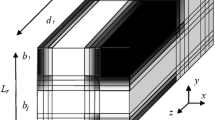Abstract
A two-level mathematical model is constructed to describe the thermomechanical interaction between structural elements of a composite (nanoclusters formed by randomly distributed anisotropic single-walled carbon nanotubes and matrix particles) and an isotropic medium possessing the desired thermoelastic characteristics. This model was first employed to obtain the thermoelastic properties of a nanocluster by the self-consistency method and then the same technique was used to describe the thermomechanical interaction of nanoclusters with an isotropic matrix of the composite. A comparative analysis of the calculated dependences for the elastic moduli of the composite and its thermal coefficient of linear expansion was carried out with two-sided estimates of these characteristics based on the dual variational formulation of the thermoelasticity problem. For comparison, the results of a numerical experiment are also used. The presented relationships make it possible to predict the thermoelastic properties of promising composites reinforced by nanoclusters.
Similar content being viewed by others
References
J. Bieksha, The Use of Composite Materials in the Military and Aerospace Industry (Bishop & Associates Inc., St. Charles, IL, 2008).
Handbook of Composites, Ed. by G. Lubin (Van Nostrand Reinold, New York, 1982).
V. V. Vasilev, Mechanics and Analysis of Composite Materials (Mashinostroenie, Moscow, 1988; Elsevier, Amsterdam, 2001).
P. Palermo, “Structural ceramic nanocomposites: a review of properties and powders’ synthesis methods,” Nanomaterials 5, 656–696 (2015).
R. Casati and M. Vedani, “Metal matrix composites reinforced by nano-particles: a review,” Metals 4, 65–83 (2014).
O. L. Blakslee, D. G. Proctor, E. J. Seldin, G. B. Spence, and T. Weng, “Elastic constants of compression-annealed pyrolytic graphite,” J. Appl. Phys. 41, 3373–3382 (1970).
E. S. Sergeeva, “Study of elastic properties of composite with ellipsoidal inclusions,” Vestn. MGTU im. N. E. Baumana, Elektron. Zh., No. 5 (2016).
J. D. Eshelby, “The continuum theory of lattice defects,” in Progress in Solid State Physics (Academic, New York, 1956), Vol. 3, pp. 79–303.
T. D. Shermergor, Theory of Elasticity of Microinhomogeneous Media (Nauka, Moscow, 1977) [in Russian].
V. S. Zarubin, Applied Problems of Thermal Strength of Structural Elements (Mashinostroenie, Moscow, 1985) [in Russian].
V. S. Zarubin and E. S. Sergeeva, “Investigation of the relationship between elastic properties of a single-walled carbon nanotubes and graphene,” Vestn. MGTU im. N. E. Baumana, Ser. Estestv. Nauki, No. 1, 100–110 (2016).
H. Jiang, B. Liu, Y. Huang, and K. C. Hwang, “Thermal expansion of single wall carbon nanotubes,” J. Eng. Mater. Technol. 126, 265–270 (2004).
I. Yu. Tsvelodub, “The inverse Eshelby tensor,” Vestn. ChGPU im. I. Ya. Yakovleva, Ser. Mekh. Predel. Sostoyaniya 8, 530–535 (2010).
V. S. Zarubin and G. N. Kuvyrkin, Mathematical Models of Continuous Media Mechanics and Electrodynamics (Mosk. Gos. Tekh. Univ. im. N. E. Baumana, Moscow, 2008) [in Russian].
V. S. Zarubin, G. N. Kuvyrkin, and I. Yu. Savel’eva, “Estimation by the self-consistency method of temperature coefficient of linear expansion with disperse inclusions,” Nauka Obrazov., El. Zh., No. 2, 197–215 (2015).
V. S. Zarubin, G. N. Kuvyrkin, and I. Yu. Savel’eva, “Comparative analysis modulus elasticity estimates for composite anisotropic spherical inclusions,” Vestn. MGTU im. N. E. Baumana, Ser. Mashinostroen., No. 6, 20–31 (2014).
V. S. Zarubin, G. N. Kuvyrkin, and I. Yu. Savel’eva, “Evaluation of the thermal expansion coefficient of a composite with disperse anisotropic inclusions by the self-consistency method,” Mech. Compos. Mater. 52, 143–154 (2016).
M. S. Shaskolskaia, Crystallography (Vyssh. Shkola, Moscow, 1976) [in Russian].
V. S. Zarubin and I. V. Stankevich, Calculation of Heat Strained Constructions (Mashinostroenie, Moscow, 2005) [in Russian].
N. N. Golovin, V. S. Zarubin, and G. N. Kuvyrkin, “Mixture models of composite mechanics. 1. Thermal mechanics and thermoelasticity of multicomponent mixture,” Vestn. MGTU im. N. E. Baumana, Ser. Estestv. Nauki, No. 3, 36–49 (2009).
Physical Values, The Handbook, Ed. by I. S. Grigor’ev and E. Z. Meilikhov (Energoatomizdat, Moscow, 1991) [in Russian].
E. S. Sergeeva, “Study of elastic properties of composites armed by nanosized inclusions,” Vestn. MGTU im. N. E. Baumana, El. Zh., No. 9 (2016).
Author information
Authors and Affiliations
Corresponding author
Additional information
Original Russian Text © V.S. Zarubin, E.S. Sergeeva, 2017, published in Matematicheskoe Modelirovanie, 2017, Vol. 29, No. 10, pp. 45–59.
Rights and permissions
About this article
Cite this article
Zarubin, V.S., Sergeeva, E.S. Application of Mathematical Modeling to Determine the Thermoelastic Characteristics of Nano-Reinforced Composites. Math Models Comput Simul 10, 288–298 (2018). https://doi.org/10.1134/S2070048218030134
Received:
Published:
Issue Date:
DOI: https://doi.org/10.1134/S2070048218030134



